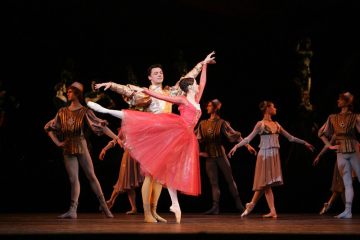Main Stage
World premiere: 26 Jun 1979 Bolshoi Theatre, Moscow, Russia Libretto after William Shakespear's tragedy Prokofiev’s “Romeo and Juliet” in Lavrovsky’s version is a “canonical” version of the ballet: not so much in the sense of an established tradition, but in connection with the choreographer’s place in the history of the appearance of this work. It was as a synthesis of two arts, a joint work of a composer and a choreographer, that “Romeo and Juliet” entered the history of the 20th century. One of the reasons why the production became a legend (and had a colossal influence on foreign choreographers as well) is the successful embodiment of the drama ballet genre, which was in demand in the USSR in the 1930-1950s and has practically not survived today. "Romeo and Juliet" is considered the pinnacle of this genre, which pays great attention to the dramatic - psychological, plot - component. In drama ballet, it is not the dancers’ technique that comes to the fore, but their acting work: the material is analyzed, the relationships between the characters appear clear to the audience, therefore a huge role is given to facial expressions, gestures and pantomime as such, and crowd scenes are developed with the detail of psychological theater. Leonid Lavrovsky participated in the creation of the second edition of the libretto for “Romeo and Juliet” - the first version, presented by Prokofiev to the Bolshoi Theater staff in 1935, was rejected (primarily because of the happy ending invented, contrary to Shakespeare’s story, in which the title characters did not die) . The dancers at neither the Bolshoi nor the Kirov (Mariinsky) theater also did not like the music itself. In 1940, Lavrovsky insisted on some modifications to the libretto and became one of its co-authors - along with Prokofiev himself and the authors of the idea - theater critic Adrian Piotrovsky and theater historian Sergei Radlov. The premiere of “Romeo and Juliet” on the Russian stage took place at the Kirov Theater in 1940, and after the war, in 1946, the production appeared on the Bolshoi stage. In both performances, Galina Ulanova played her greatest role. At the Bolshoi Theater, “Romeo and Juliet” in Lavrovsky’s version was shown intermittently from the moment of its premiere until the early 2000s. The current version was staged by Mikhail Lavrovsky, the son of the choreographer, an outstanding Russian dancer, for whom the role of Romeo in his father’s ballet became one of the most important. The production will preserve the legendary scenography of the first production, created by Peter Williams (set restoration designer - Sergei Grachev). “The performance by Lavrovsky and Peter Williams, the ballet’s director, was usually called a canvas in the press, so grandiose did the ballet picture of early Renaissance Italy look,” the Bolshoi Theater recalls in its announcement of the premiere. — In this performance, the love “red” line clearly ran between two hostile worlds, and the power of love was increased tenfold by the desire for freedom. In the person of the lovers and their peers, the approach of the enlightened Renaissance announced itself; with the ominous tread of the Capulet clan, the gloomy Middle Ages fiercely defended its positions; evoking associations with François Villon or François Rabelais, he derived Mercutio’s own sarcastic theme; the rapier ringing of the vendetta was opposed by the quiet peace of the cell of the Franciscan Father Lorenzo; Brunelleschi’s Florentine dome hovered over Verona Square, and the castle was filled with girls who looked like they had stepped out of Botticelli’s paintings.” Inspired by Williams' sketches, costumes for the new production are created by Tatyana Noginova. Lighting designer Damir Ismagilov is also working on the performance. The conductor and director of the new Romeo and Juliet is Anton Grishanin.
Romeo and Juliet is a ballet by Sergei Prokofiev based on William Shakespeare's play Romeo and Juliet. It is one of the most enduringly popular ballets. Music from the ballet was extracted by Prokofiev as three suites for orchestra and as a piano work. SynopsisAct l © Bolshoi Theatre | ||||||||||


